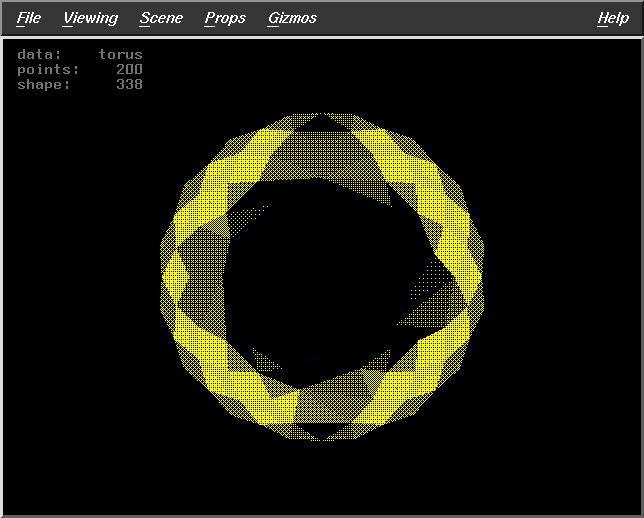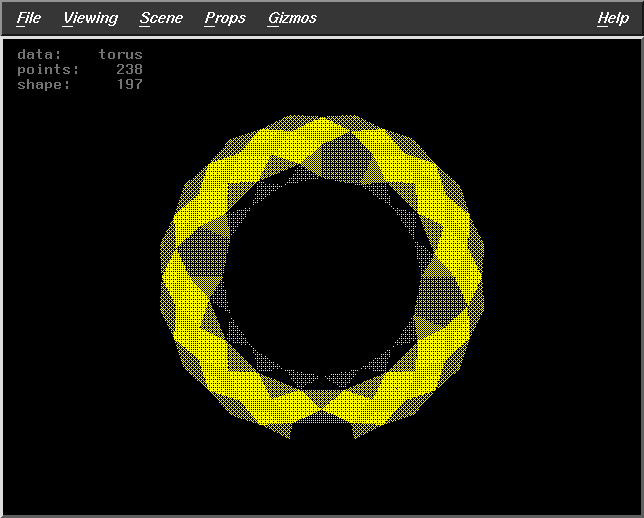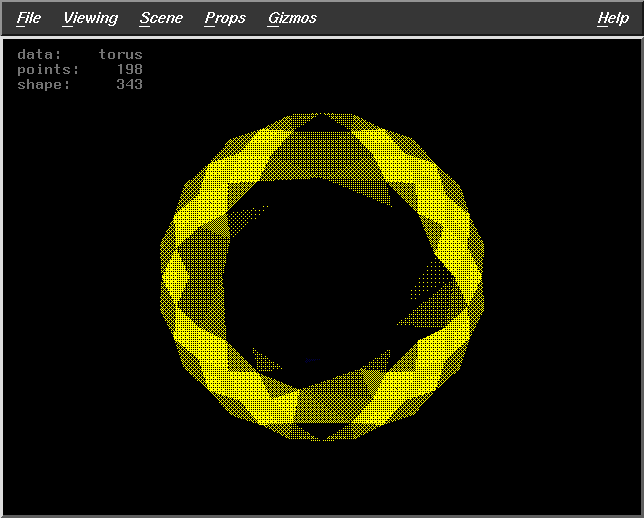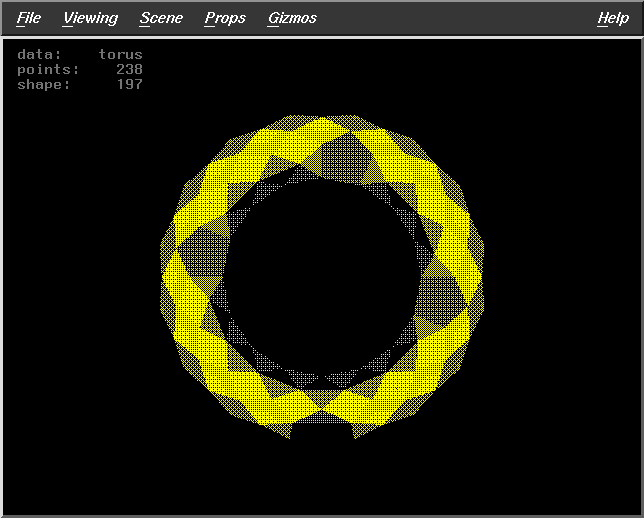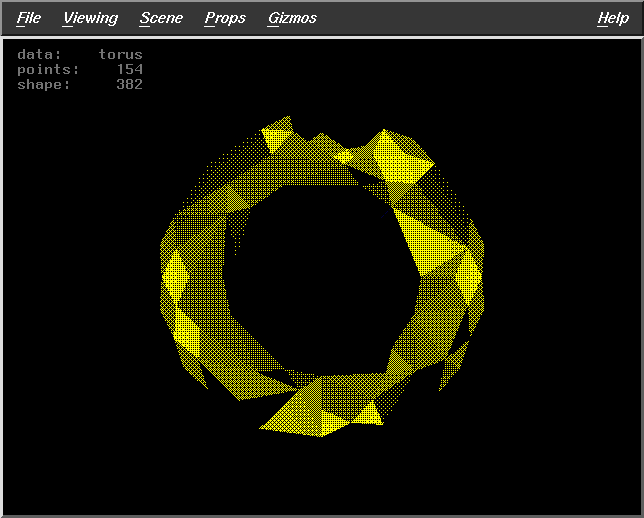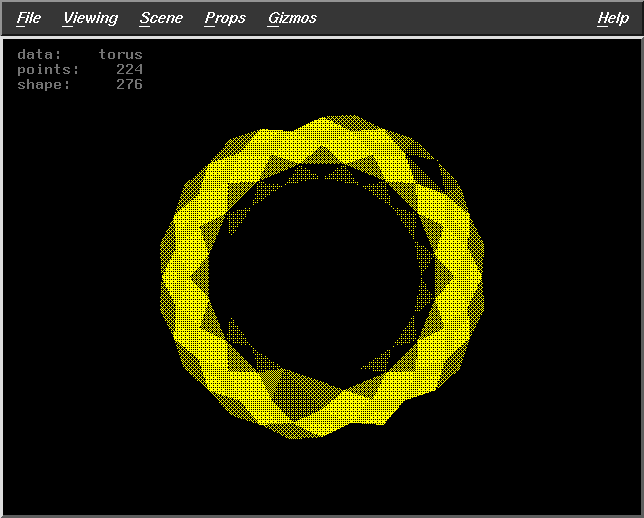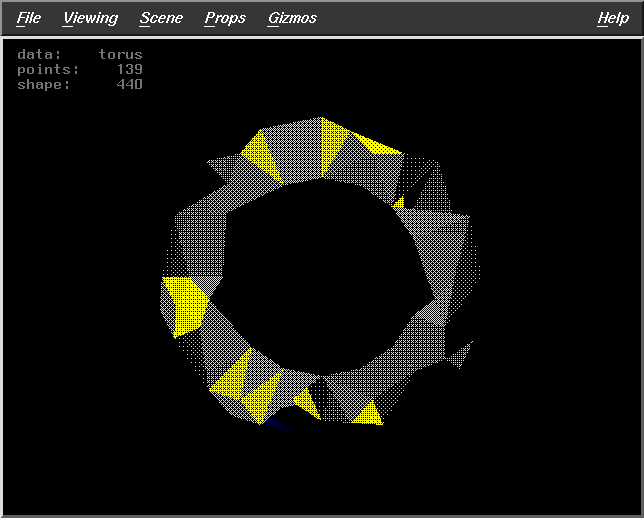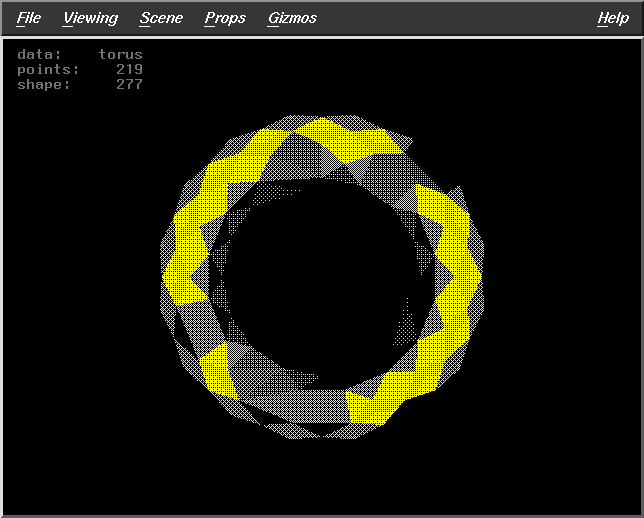3D Surface Reconstruction from point data
CAED (ME451) Project Report
|
by
Sachin
Maheshwari (94240)
&
Anoop
Jayadevan (94038)
Objective
To study the method of using Alpha Shapes for 3D surface reconstruction
and look into the 3D scaling aspects on 3D point data set
Motivation
In many scientific simulation there has always been a need to visualize
an extrapolation of the point data produced from the experiments. In view
of the necessity for such simulation to be rendered in a much shorter time
than a full detailed visualization would take, we thought of devising scaling
algorithms for reducing the number of points required to create the surface.
The constraint is that the surface generated by using lesser no of points
resembles the original surface.
The report is divided in to the following sections
:
Introduction
Alpha Shape
Alpha shapes are a generalization of the convex hull of a point set.
It can be used to fit a smooth surface through points in 3D space. The
surface may be disjoint. It's a very clean and general method of creating
3D surfaces.
The complete mathematical definition of alpha shapes is quite is quite
involved, and is given in [2]. Intuitively we can describe
alpha shapes as follows :
Let the point set be S. Think of R3 filled with Styrofoam
and the points of S made of more solid material such as rock. Now imagine
a spherical eraser with radius alpha. It's omnipresent in the sense that
it carves out Styrofoam at all positions where it does not enclose any
of the sprinkled rocks, i.e., points of S. The resulting object will be
called the alpha hull. To make things more feasible We straighten the surface
of the object by substituting straight edges for the circular ones and
triangles for spherical caps. The object obtained is the alpha shape of
S. It's a polytope in a fairly general sense. It can be concave or even
disconnected. It can contain 2D patches of triangles and 1 dimensional
strings of edges; and it's components can be as small as single points.
The parameter alpha controls the maximum ``curvature '' of any cavity of
the polytope.
Scaling of 3D Shapes
The intention is to drop points from the 3D data set, so that the time
taken for surface generation is reduced, on the cost of losing some minor
details in the surface. But the overall surface generated should resemble
the original. For this we have devised different metrics and scaling algorithms
which is discussed in the next section.
back to the index
Past Work
Herbert Edelsbrunner & Ernst P. Mucke at NCSA UIUC, have been
working extensively on 3D surface generation using alpha shapes. They have
provided a rigorous and mathematical definition of alpha shapes in [2]
A research release of the implementatiion of their work is available
via ftp at [ftp://ftp.ncsa.uiuc.edu/Visualization/Alpha-shape/alpha-2.2/alpha-2.2.sgi.tar.gz]
back to the index
Methodology Used
Alpha shape generation goes through following stages :
- Delaunay triangulation
- The definition of Delaunay triangulation is given in [2].
The alpha visualizer employs a variant of the randomized incremental-flip
algorithm due to Edelsbrunner and Shah [3]. The variant
and its data structure is described in more detail in Mucke [4].
- Computation of the Alpha interval
Algorithms for Scaling
The distance referred to in this Algorithm is calculated using 3 different
metrics. The details of the metrics are given in the
next section.
step 1 : Sort the points in S (using Quick Sort) and remove
duplicates
step 2 : Calculate the standard deviation of the x coordinates,
y coordinates and z coordinates of the points
step 3 : Sort the points with the coordinate with maximum deviation
first, the coordinate with second maximum deviation second and so
on
(Now, in the sorted order, if two points are consecutive then they
are most likely to be in the same cluster. The heuristic of sorting after
finding the standard deviation may be replaced by a better measure of locality)
step 4 : Calculate the threshold as the fraction of the distance
between the extreme points
step 5: A window, whose size depends on the number of windows needed,
centered around each point is moved from the first point to the last point.
For each point in the window do the following
Find the distance of each point from the center of the window. If
this distance is less than the threshold then we add this point to the
proximity list of the center of the window. Also find the size of each
list and the maximum and minimum size so far.
(Now we have the proximity list for all the points)
step 6: Drop all points with size of proximity list greater than
the critical_distance with some probability. ( Note : We take the critical_distance
into consideration to retain the sparse points of the surface. The probabilistic
dropping is to take care of the other extreme, i.e., all the points belonging
to a cluster may be dropped).
We now have a set of points, with cardinality less than that of S, which
retains all the ``important'' features of the original, but removes most
of the minor details.
As the Delaunay triangulation and subsequent alpha shape generation
time are heavily dependent on the cardinality of S, we are saving on time
by reducing the cardinality of the point set.
back to the index
Distance Metrics
The L one metric
Distance between (x1,y1,z1)
and (x2,y2,z2) is
|(x1-x2)| + |(y1-y2)|
+ |(z1-z2)|
The L infinity metric
Distance between (x1,y1,z1)
and (x2,y2,z2) is
maximum ( |(x1-x2)| ,|(y1-y2)|
,|(z1-z2)| )
The Euclidean distance metric
Distance between (x1,y1,z1)
and (x2,y2,z2) is
sqrt ( (x1-x2)2+ (y1-y2)2
+ (z1-z2)2 )
We are using L one and L infinity metric so that we can
work with long integer arithmetic. This considerably speeds up the computation.
back to the index
Results
We have implemented these algorithms and incorporated it into the code
of the alpha-visualizer. The test runs of the visualizer gave the following
results on surface reconstruction of a torus using a point data set of
size 256. The parameters that may be varied are :
- Algorithm
- Fraction of the maximum distance to be considered.
- A parameter to govern the window size
- Probability of dropping a selected point, a number ``n'' in the following
table implies a probability of 1/n.
The results for the three algorithms are :
Results for Algorithm 1
Results for Algorithm 2
Fract=0.5
WS=10
DF=2
Pts=155 |
Fract=0.5
WS=10
DF=7
Pts=224 |
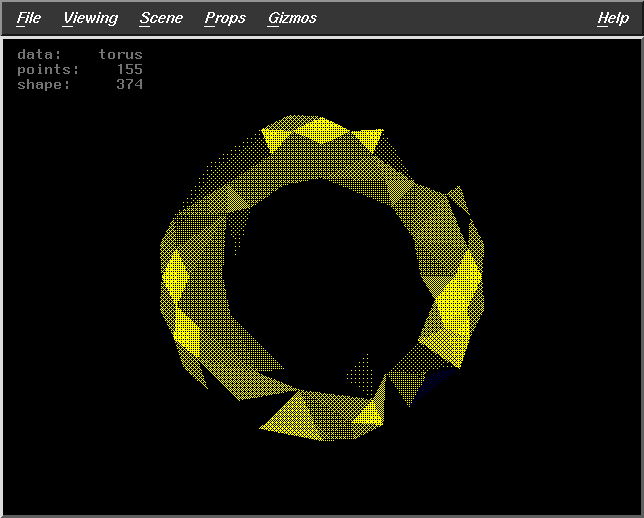 |
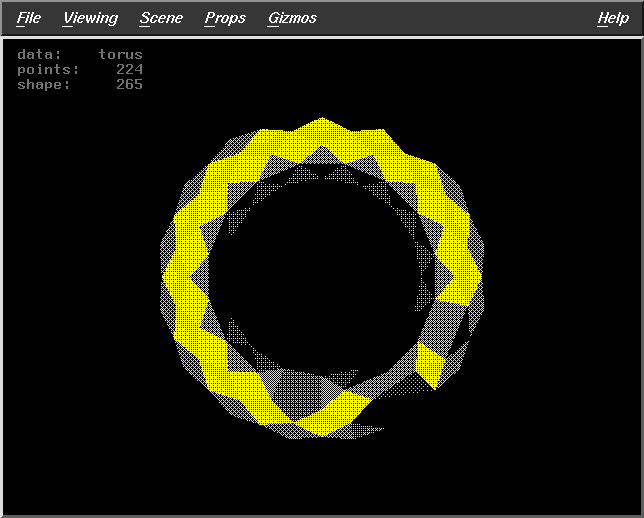 |
Fract=0.5
WS=30
DF=2
Pts=139 |
Fract=0.5
WS=30
DF=7
Pts=219 |
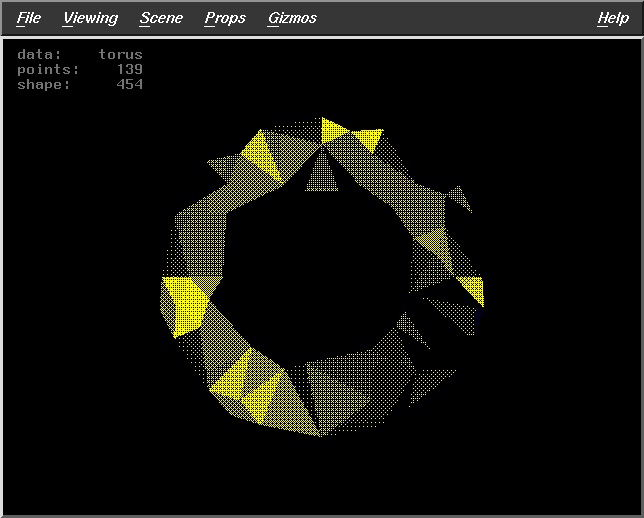 |
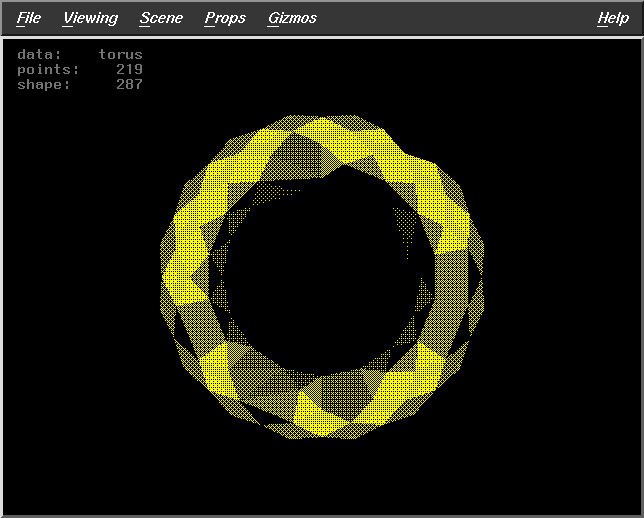 |
Fract=0.8
WS=10
DF=2
Pts=154 |
Fract=0.8
WS=10
DF=7
Pts=224 |
 |
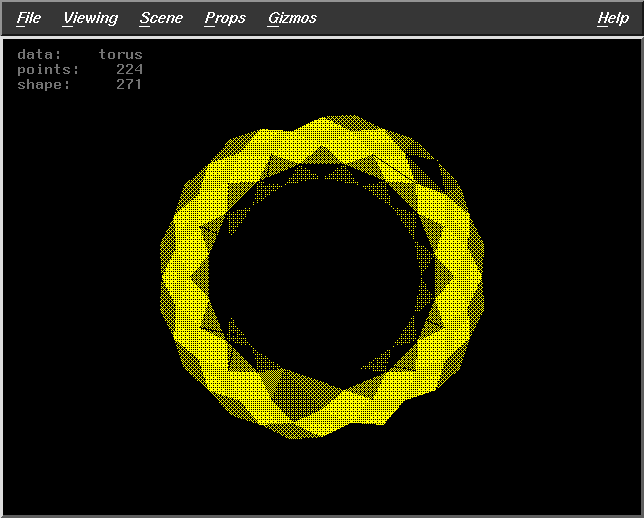 |
Fract= 0.8
WS=30
DF=2
Pts=139 |
Fract=0.8
WS=30
DF=7
Pts=219 |
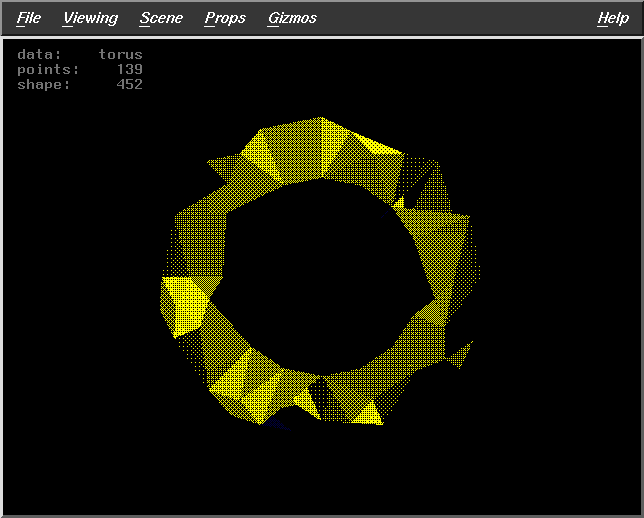 |
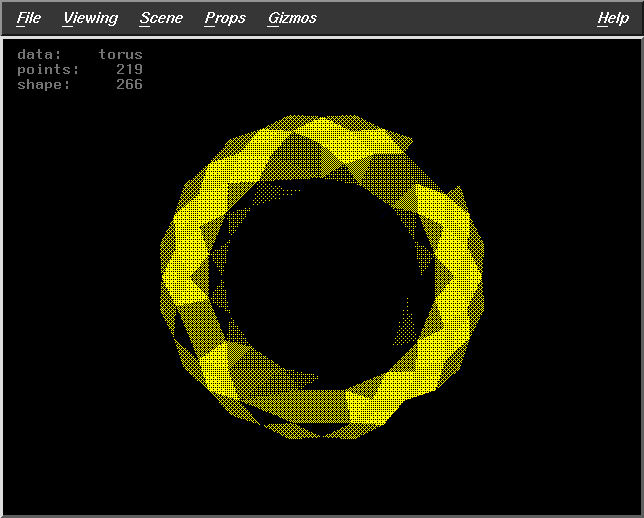 |
Results for Algorithm 3
Fract=0.5
WS=10
DF=2
Pts=158 |
Fract=0.5
WS=10
DF=7
Pts=224 |
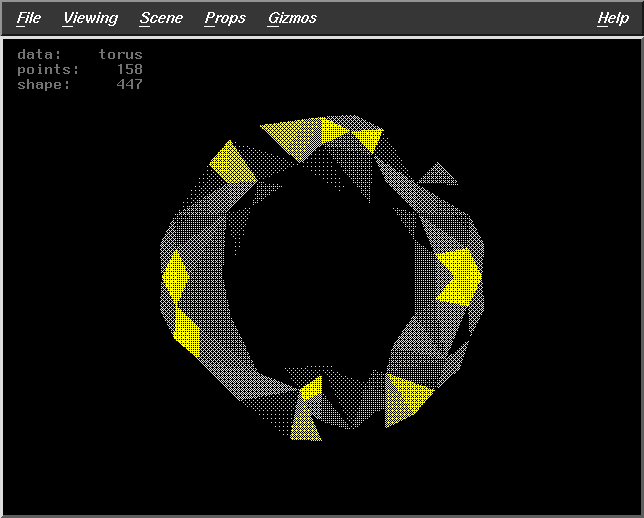 |
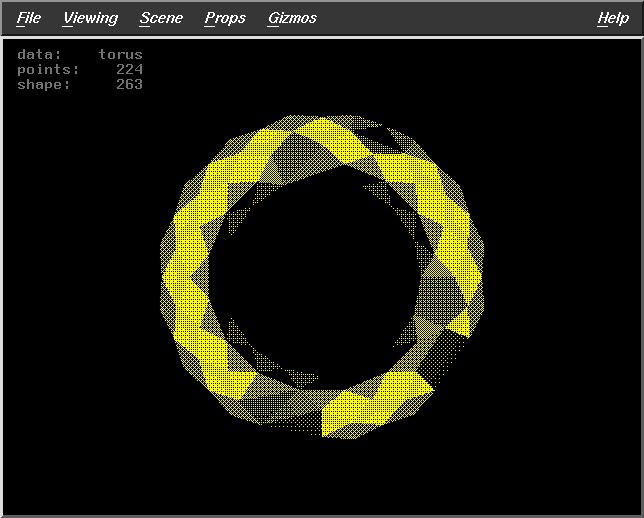 |
Fract=0.5
WS=30
DF=2
Pts=145 |
Fract=0.5
WS=30
DF=7
Pts=220 |
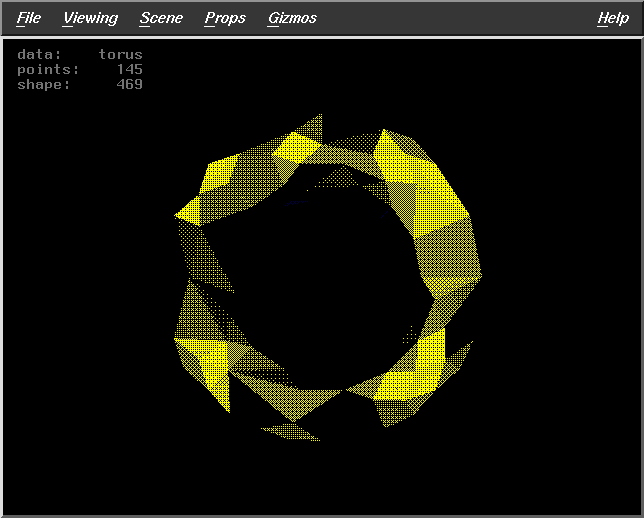 |
 |
Fract=0.8
WS=10
DF=2
Pts=154 |
Fract=0.8
WS=10
DF=7
Pts=224 |
 |
 |
Fract=0.8
WS=30
DF=2
Pts=139 |
Fract=0.8
WS=30
DF=7
Pts=219 |
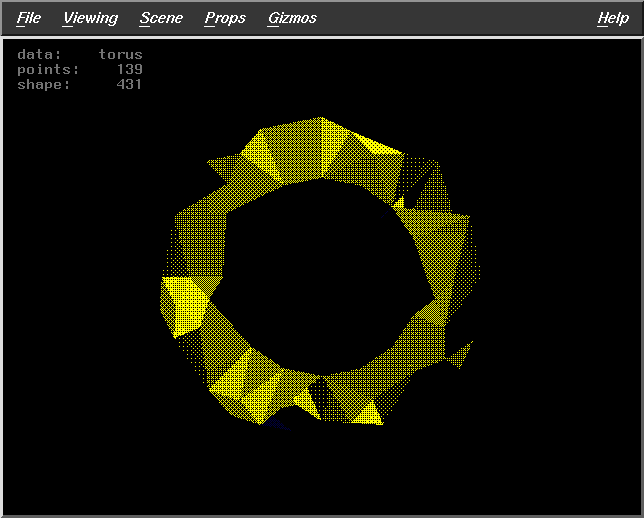 |
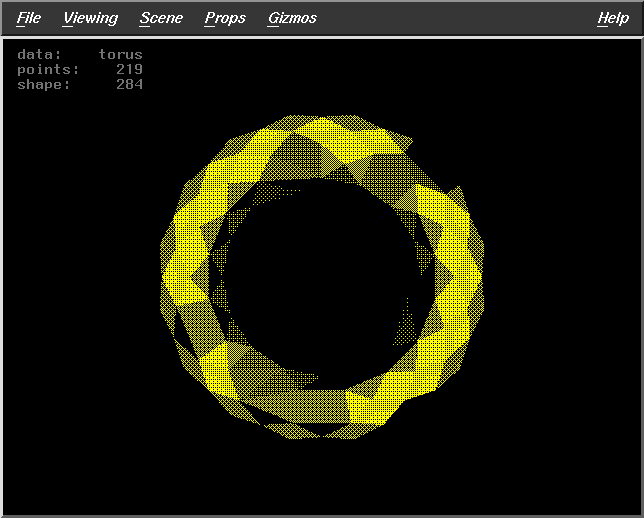 |
back to the index
Observation
back to the index
Conclusion
We have devised a new algorithm to reduce the number of points needed
for alpha shape generation that retains the important features of the original
surface and speeds up the generation of alpha shape at the cost of losing
some minor details. The results that we got were quite satisfactory. Improvements
can be done to the algorithm by using better metrics to find clusters and
dropping probability can also be made dependent on some cluster properties.
back to the index
References
[1] ``Surface Reconstruction : From points to Splines'',
Baining Guo, CAD, vol 29, No. 2, 1997
[2] ``Three-Dimensional Alpha Shapes'', Herbert Edelsbrunner,
Ernst P. Mucke, ACM Transaction on Graphics, vol 13, No. 1, Jan 1994, p43-72
[ftp://cs.uiuc.edu/pub/edels/geometry/shapes-94.Z]
[3] ``Incremental topological flipping works for
regular triangulations. Herbert Edelsbrunner, Nimish Shah, Proceedings
of the 8th Annual Symposium on Computational Geometry, 1992, 43-52.
[4] ``Shapes and Implementations in Three-Dimensional
Geometry'', Ernst Mucke, Ph.D. Thesis, Department of Computer Science,
University of Illinois at Urbana Champaign. Technical Report UIUCDCS-R-93-1836.
[ftp://cs.uiuc.edu/pub/TechReports/UIUCDCS-R-93-1836.ps.Z].
back to the index
This page is maintained by Anoop Jayadevan
(anoop@cd1) and Sachin
Maheshwari (sach@cd1)
